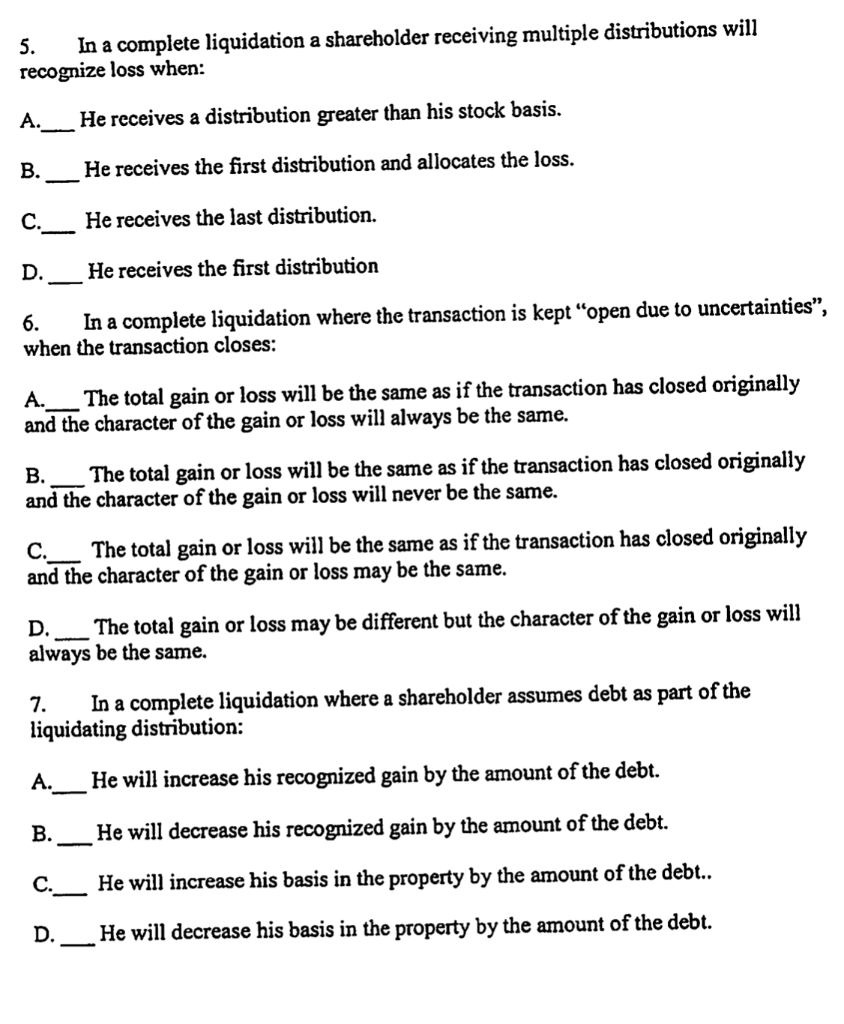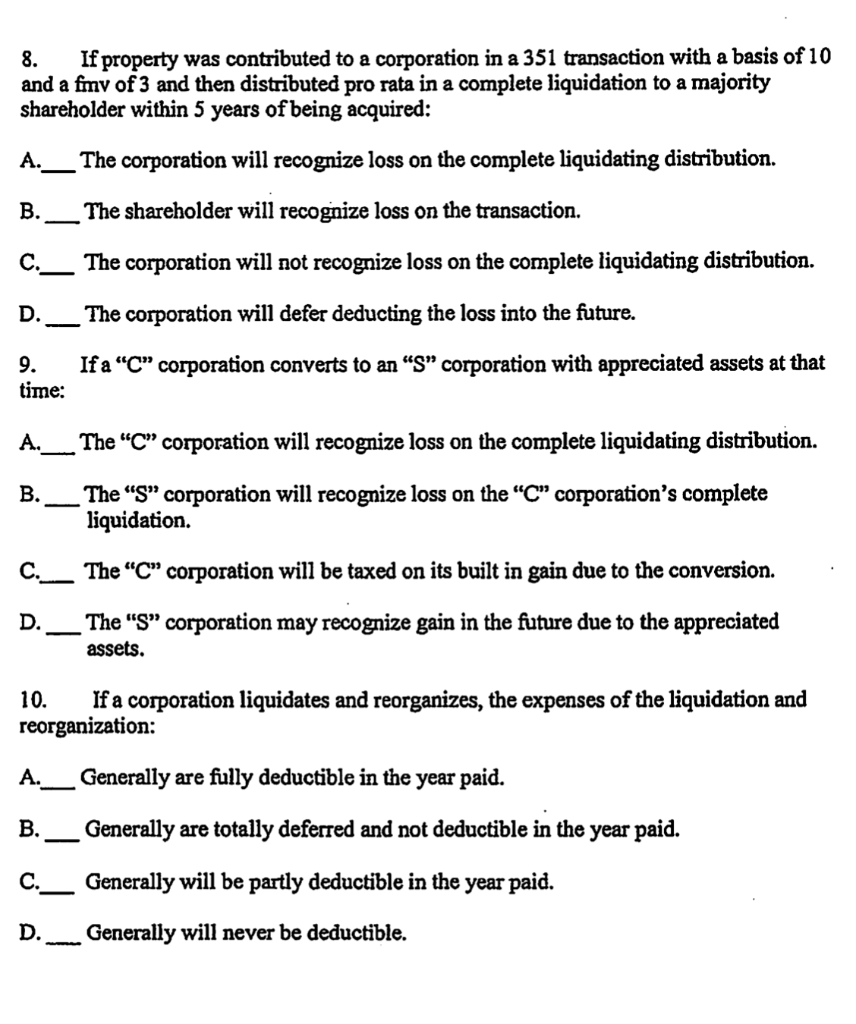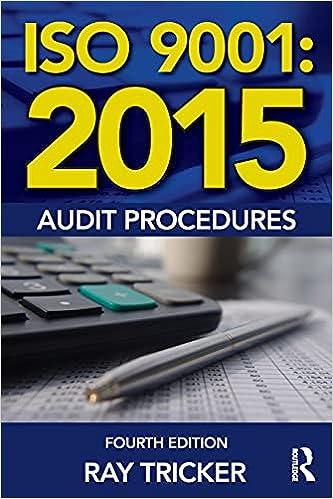Question
Please answer the multiple choice questions # 5-10: 5. In a complete liquidation a shareholder receiving multiple distributions will recognize loss when: He receives a
Please answer the multiple choice questions # 5-10:
5. In a complete liquidation a shareholder receiving multiple distributions will recognize loss when:
-
He receives a distribution greater than his stock basis
-
He receives the first distribution and allocates the loss
-
He receives the last distribution
-
He receives the first distribution
6. In a complete liquidation where the transaction is kept open due to uncertainties, when a transaction closes:
-
The total gain or loss will be the same as if the transaction has closed originally and the character of the gain or loss will always be the same
-
The total gain or loss will be the same as if the transaction has closed originally and the character of the gain or loss will never be the same
-
The total gain or loss will be the same as of the transaction has closed originally and the character of the gain or loss may be the same
-
The total gain or loss may be different but the character of the gain or loss will always be the same
7. In a complete liquidation where a shareholder assumes debt as part of the liquidating distribution:
A. He will increase his recognized gain by the amount of the debt.
B. He will decreases his recognized gain by the amount of the debt
C. He will increase his basis in the property by the amount of the debt
D. He will decrease his basis in the property by the amount of the debt
8. If property was contributed to a corporation and a 351 transaction with a basis of 10 and a fair market value of 3 and then distributed pro rata in a complete liquidation to a majority shareholder within 5 years of being acquired:
-
The corporation will recognize loss on the complete liquidating distribution.
-
The shareholder will recognize loss on the transaction.
-
The corporation will not recognize loss on the complete liquidating distribution.
-
The corporation will defer deducting the loss into the future.
9. If a C corporation converts to an S corporation with appreciated assets at that time:
-
The C corporation will recognize loss on the complete liquidating distribution.
-
The S corporation will recognize loss on the C corporation's complete liquidation.
-
The C corporation will be taxed on its built in gain due to the conversion.
-
The S corporation may recognize gain in the future due to the appreciated assets.
10. If a corporation liquidates and reorganizes, the expenses of the liquidation and reorganization:
-
Generally are fully deductible in the year paid.
-
Generally are totally deferred and not deductible in the year paid.
-
Generally will be partly deductible in the year paid.
-
Generally will never be deductible.


Textbook: Federal Income Taxation of Corporations and Shareholders, 7th Edition
Course: Taxation of Reorganizations & Liquidations
5. In a complete liquidation a shareholder receiving multiple distributions will recognize loss when: A.__ He receives a distribution greater than his stock basis. He receives the first distribution and allocates the loss. C.__ He receives the last distribution. He receives the first distribution 6. In a complete liquidation where the transaction is kept "open due to uncertainties, when the transaction closes: A.__ The total gain or loss will be the same as if the transaction has closed originally and the character of the gain or loss will always be the same. B. The total gain or loss will be the same as if the transaction has closed originally and the character of the gain or loss will never be the same. C. _ The total gain or loss will be the same as if the transaction has closed originally and the character of the gain or loss may be the same. D._ The total gain or loss may be different but the character of the gain or loss will always be the same. 7. In a complete liquidation where a shareholder assumes debt as part of the liquidating distribution: A._ He will increase his recognized gain by the amount of the debt. He will decrease his recognized gain by the amount of the debt. He will increase his basis in the property by the amount of the debt.. D. He will decrease his basis in the property by the amount of the debt. 8. If property was contributed to a corporation in a 351 transaction with a basis of 10 and a fmv of 3 and then distributed pro rata in a complete liquidation to a majority shareholder within 5 years of being acquired: A. The corporation will recognize loss on the complete liquidating distribution. The shareholder will recognize loss on the transaction. W C.__ The corporation will not recognize loss on the complete liquidating distribution. D. _ The corporation will defer deducting the loss into the future. 9. If a C corporation converts to an S corporation with appreciated assets at that time: A._ The C corporation will recognize loss on the complete liquidating distribution. B. _ The S corporation will recognize loss on the C corporation's complete liquidation. C. __ The C corporation will be taxed on its built in gain due to the conversion. D. _ The S corporation may recognize gain in the future due to the appreciated assets. 10. If a corporation liquidates and reorganizes, the expenses of the liquidation and reorganization: A.__ Generally are fully deductible in the year paid. B.__Generally are totally deferred and not deductible in the year paid. C.__ Generally will be partly deductible in the year paid. Generally will never be deductibleStep by Step Solution
There are 3 Steps involved in it
Step: 1

Get Instant Access to Expert-Tailored Solutions
See step-by-step solutions with expert insights and AI powered tools for academic success
Step: 2

Step: 3

Ace Your Homework with AI
Get the answers you need in no time with our AI-driven, step-by-step assistance
Get Started


